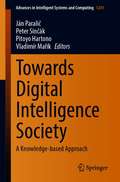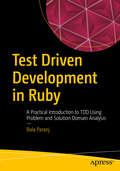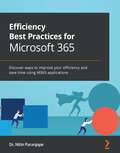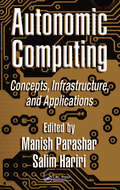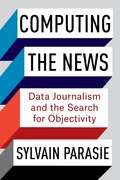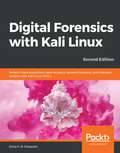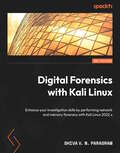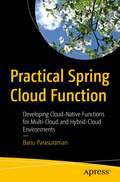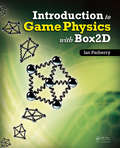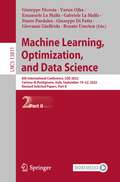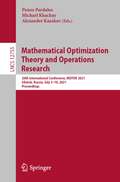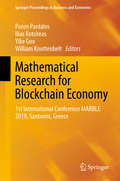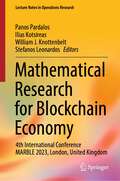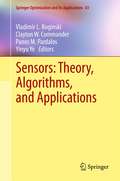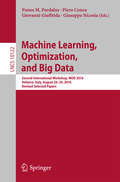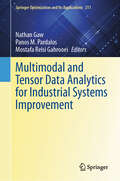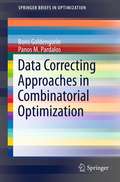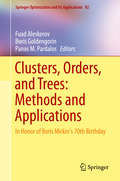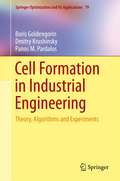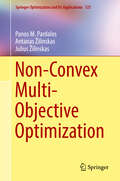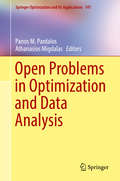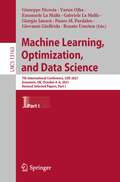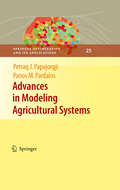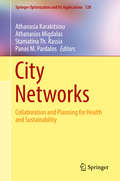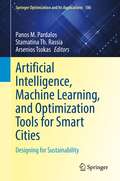- Table View
- List View
Towards Digital Intelligence Society: A Knowledge-based Approach (Advances in Intelligent Systems and Computing #1281)
by Ján Paralič Peter Sinčák Pitoyo Hartono Vladimír MaříkThis book aims to provide readers with up-to-date knowledge on how to make these technologies smarter. Humanity is now going through difficult times to fight the Covid-19 pandemic. Simultaneously, in these difficult times of physical separation, we can also realize how much digital society technology helps us cope with many difficulties that bring us this time. The authors focus on selected research challenges for intelligent digital society and state-of-the-art methods of how to face them. The book’s subtitle suggests that a core concept that the reader can study from various points of view in particular book chapters is the knowledge. The knowledge that can help us intelligently face different digital society challenges (Part I of this book); the knowledge extracted from available big data employing intelligent analysis techniques (Part II). For efficient processing and analysis of data, there is a strong need for smart data and information modeling techniques (Part III).
Test Driven Development in Ruby
by Bala ParanjLearn the basics of test driven development (TDD) using Ruby. You will carry out problem domain analysis, solution domain analysis, designing test cases, and writing tests first. These fundamental concepts will give you a solid TDD foundation to build upon. Test Driven Development in Ruby is written by a developer for developers. The concepts are first explained, then a coding demo illustrates how to apply the theory in practice. At the end of each chapter an exercise is given to reinforce the material. Complete with working files and code samples, you'll be able to work alongside the author, a trainer, by following the material in this book. What You Will Learn Carry out problem domain analysis, solution domain analysis, designing test cases, and writing tests first Use assertions Discover the structure of a test and the TDD cycle Gain an understanding of minimal implementation, starter test, story test, and next test Handle refactoring using Ruby Hide implementation details Test precisely and concretely Make your code robust Who This Book Is For Experienced Ruby programmers or web developers with some prior experience with Ruby.
Efficiency Best Practices for Microsoft 365: Discover ways to improve your efficiency and save time using M365 applications
by Dr. Nitin ParanjapeA practical guide to working with Microsoft 365 apps such as Office, Teams, Excel, and Power BI for automating tasks and managing projects effectivelyKey FeaturesLearn how to save time while using M365 apps from Microsoft productivity expert Dr. Nitin ParanjapeDiscover smarter ways to work with over 20 M365 apps to enhance your efficiencyUse Microsoft 365 tools to automate repetitive tasks without codingBook DescriptionEfficiency Best Practices for Microsoft 365 covers the entire range of over 25 desktop and mobile applications on the Microsoft 365 platform. This book will provide simple, immediately usable, and authoritative guidance to help you save at least 20 minutes every day, advance in your career, and achieve business growth.You'll start by covering components and tasks such as creating and storing files and then move on to data management and data analysis. As you progress through the chapters, you'll learn how to manage, monitor, and execute your tasks efficiently, focusing on creating a master task list, linking notes to meetings, and more. The book also guides you through handling projects involving many people and external contractors/agencies; you'll explore effective email communication, meeting management, and open collaboration across the organization. You'll also learn how to automate different repetitive tasks quickly and easily, even if you're not a programmer, transforming the way you import, clean, and analyze data.By the end of this Microsoft 365 book, you'll have gained the skills you need to improve efficiency with the help of expert tips and techniques for using M365 apps.What you will learnUnderstand how different MS 365 tools, such as Office desktop, Teams, Power BI, Lists, and OneDrive, can increase work efficiencyIdentify time-consuming processes and understand how to work through them more efficientlyCreate professional documents quickly with minimal effortWork across multiple teams, meetings, and projects without email overloadAutomate mundane, repetitive, and time-consuming manual workManage work, delegation, execution, and project managementWho this book is forIf you use Microsoft 365, including MS Office 365, on a regular basis and want to learn about the features that can help improve your efficiency, this book is for you. You do not require any specialized knowledge to get started.
Autonomic Computing: Concepts, Infrastructure, and Applications
by Manish Parashar Salim HaririThe complexity of modern computer networks and systems, combined with the extremely dynamic environments in which they operate, is beginning to outpace our ability to manage them. Taking yet another page from the biomimetics playbook, the autonomic computing paradigm mimics the human autonomic nervous system to free system developers and administrators from performing and overseeing low-level tasks. Surveying the current path toward this paradigm, Autonomic Computing: Concepts, Infrastructure, and Applications offers a comprehensive overview of state-of-the-art research and implementations in this emerging area.This book begins by introducing the concepts and requirements of autonomic computing and exploring the architectures required to implement such a system. The focus then shifts to the approaches and infrastructures, including control-based and recipe-based concepts, followed by enabling systems, technologies, and services proposed for achieving a set of "self-*" properties, including self-configuration, self-healing, self-optimization, and self-protection. In the final section, examples of real-world implementations reflect the potential of emerging autonomic systems, such as dynamic server allocation and runtime reconfiguration and repair.Collecting cutting-edge work and perspectives from leading experts, Autonomic Computing: Concepts, Infrastructure, and Applications reveals the progress made and outlines the future challenges still facing this exciting and dynamic field.
Computing the News: Data Journalism and the Search for Objectivity
by Sylvain ParasieFaced with a full-blown crisis, a growing number of journalists are engaging in seemingly unjournalistic practices such as creating and maintaining databases, handling algorithms, or designing online applications. “Data journalists” claim that these approaches help the profession demonstrate greater objectivity and fulfill its democratic mission. In their view, computational methods enable journalists to better inform their readers, more closely monitor those in power, and offer deeper analysis. In Computing the News, Sylvain Parasie examines how data journalists and news organizations have navigated the tensions between traditional journalistic values and new technologies. He traces the history of journalistic hopes for computing technology and contextualizes the surge of data journalism in the twenty-first century. By importing computational techniques and ways of knowing new to journalism, news organizations have come to depend on a broader array of human and nonhuman actors. Parasie draws on extensive fieldwork in the United States and France, including interviews with journalists and data scientists as well as a behind-the-scenes look at several acclaimed projects in both countries. Ultimately, he argues, fulfilling the promise of data journalism requires the renewal of journalistic standards and ethics. Offering an in-depth analysis of how computing has become part of the daily practices of journalists, this book proposes ways for journalism to evolve in order to serve democratic societies.
Digital Forensics with Kali Linux: Perform data acquisition, data recovery, network forensics, and malware analysis with Kali Linux, 2nd Edition
by Shiva V. ParasramTake your forensic abilities and investigation skills to the next level using powerful tools that cater to all aspects of digital forensic investigations, right from hashing to reporting Key Features Perform evidence acquisition, preservation, and analysis using a variety of Kali Linux tools Use PcapXray to perform timeline analysis of malware and network activity Implement the concept of cryptographic hashing and imaging using Kali Linux Book Description Kali Linux is a Linux-based distribution that's widely used for penetration testing and digital forensics. It has a wide range of tools to help for digital forensics investigations and incident response mechanisms. This updated second edition of Digital Forensics with Kali Linux covers the latest version of Kali Linux and The Sleuth Kit. You'll get to grips with modern techniques for analysis, extraction, and reporting using advanced tools such as FTK Imager, hex editor, and Axiom. Updated to cover digital forensics basics and advancements in the world of modern forensics, this book will also delve into the domain of operating systems. Progressing through the chapters, you'll explore various formats for file storage, including secret hiding places unseen by the end user or even the operating system. The book will also show you how to create forensic images of data and maintain integrity using hashing tools. Finally, you'll cover advanced topics such as autopsies and acquiring investigation data from networks, operating system memory, and quantum cryptography. By the end of this book, you'll have gained hands-on experience of implementing all the pillars of digital forensics: acquisition, extraction, analysis, and presentation, all using Kali Linux tools. What you will learn Get up and running with powerful Kali Linux tools for digital investigation and analysis Perform internet and memory forensics with Volatility and Xplico Understand filesystems, storage, and data fundamentals Become well-versed with incident response procedures and best practices Perform ransomware analysis using labs involving actual ransomware Carry out network forensics and analysis using NetworkMiner and other tools Who this book is for This Kali Linux book is for forensics and digital investigators, security analysts, or anyone interested in learning digital forensics using Kali Linux. Basic knowledge of Kali Linux will be helpful to gain a better understanding of the concepts covered.
Digital Forensics with Kali Linux: Enhance your investigation skills by performing network and memory forensics with Kali Linux 2022.x, 3rd Edition
by Shiva V. ParasramExplore various digital forensics methodologies and frameworks and manage your cyber incidents effectivelyPurchase of the print or Kindle book includes a free PDF eBookKey FeaturesGain red, blue, and purple team tool insights and understand their link with digital forensicsPerform DFIR investigation and get familiarized with Autopsy 4Explore network discovery and forensics tools such as Nmap, Wireshark, Xplico, and ShodanBook DescriptionKali Linux is a Linux-based distribution that's widely used for penetration testing and digital forensics. This third edition is updated with real-world examples and detailed labs to help you take your investigation skills to the next level using powerful tools.This new edition will help you explore modern techniques for analysis, extraction, and reporting using advanced tools such as FTK Imager, Hex Editor, and Axiom. You'll cover the basics and advanced areas of digital forensics within the world of modern forensics while delving into the domain of operating systems. As you advance through the chapters, you'll explore various formats for file storage, including secret hiding places unseen by the end user or even the operating system. You'll also discover how to install Windows Emulator, Autopsy 4 in Kali, and how to use Nmap and NetDiscover to find device types and hosts on a network, along with creating forensic images of data and maintaining integrity using hashing tools. Finally, you'll cover advanced topics such as autopsies and acquiring investigation data from networks, memory, and operating systems.By the end of this digital forensics book, you'll have gained hands-on experience in implementing all the pillars of digital forensics: acquisition, extraction, analysis, and presentation – all using Kali Linux's cutting-edge tools.What you will learnInstall Kali Linux on Raspberry Pi 4 and various other platformsRun Windows applications in Kali Linux using Windows Emulator as WineRecognize the importance of RAM, file systems, data, and cache in DFIRPerform file recovery, data carving, and extraction using Magic RescueGet to grips with the latest Volatility 3 framework and analyze the memory dumpExplore the various ransomware types and discover artifacts for DFIR investigationPerform full DFIR automated analysis with Autopsy 4Become familiar with network forensic analysis tools (NFATs)Who this book is forThis book is for students, forensic analysts, digital forensics investigators and incident responders, security analysts and administrators, penetration testers, or anyone interested in enhancing their forensics abilities using the latest version of Kali Linux along with powerful automated analysis tools. Basic knowledge of operating systems, computer components, and installation processes will help you gain a better understanding of the concepts covered.
Practical Spring Cloud Function: Developing Cloud-Native Functions for Multi-Cloud and Hybrid-Cloud Environments
by Banu ParasuramanUnlike other resources that target only programming communities, this book targets both programming and business communities. With programming models shifting more towards no-code and low-code, citizen programmers from the business side will welcome this book as a guide for how to design and optimize their information pipeline while lowering costs for infrastructure. Programmers, on the other hand, will welcome this book's business-centric programming view, which will get them a step closer to fulfilling real business requirements. Practical Spring Cloud Function touches on the themes of portability, scalability, high performance and high availability. Each theme is explored via a real enterprise use case and code. The use cases target industries including energy (oil pipeline sensors), automotive (event-driven connected vehicles), and retail (conversational AI). After reading this book, you'll come away with the know-how to build and deploy cloud-native Java applications effectively and efficiently. What You Will LearnWrite functions and deploy to Amazon Web Services, Microsoft Azure, Google Cloud, IBM Cloud, and on-prem clouds such as VMWare Tanzu and RedHat OpenShiftSet up locally with KNative on Kubernetes, as well as on AWS, Azure, GCP, Tanzu, and othersBuild, test, and deploy a simple example with Spring Cloud FunctionDevelop an event-driven data pipeline with Spring Cloud FunctionIntegrate with AI and machine learning modelsApply Spring Cloud Function to the Internet of Things (IoT)Get industry-specific examples of Spring Cloud Function in actionWho This Book Is For Software and cloud-native application developers with prior programming experience in the cloud and/or Spring Framework. DevOps professionals may find this book beneficial as well.
Introduction to Game Physics with Box2D
by Ian ParberryWritten by a pioneer of game development in academia, Introduction to Game Physics with Box2D covers the theory and practice of 2D game physics in a relaxed and entertaining yet instructional style. It offers a cohesive treatment of the topics and code involved in programming the physics for 2D video games. Focusing on writing elementary game physics code, the first half of the book helps you grasp the challenges of programming game physics from scratch, without libraries or outside help. It examines the mathematical foundation of game physics and illustrates how it is applied in practice through coding examples. The second half of the book shows you how to use Box2D, a popular open source 2D game physics engine. A companion website provides supplementary material, including source code and videos. This book helps you become a capable 2D game physics programmer through its presentation of both the theory and applications of 2D game physics. After reading the book and experimenting with the code samples, you will understand the basics of 2D game physics and know how to use Box2D to make a 2D physics-based game.
Machine Learning, Optimization, and Data Science: 8th International Workshop, LOD 2022, Certosa di Pontignano, Italy, September 19–22, 2022, Revised Selected Papers, Part II (Lecture Notes in Computer Science #13811)
by Panos Pardalos Giuseppe Di Fatta Giuseppe Nicosia Giovanni Giuffrida Renato Umeton Varun Ojha Emanuele La Malfa Gabriele La MalfaThis two-volume set, LNCS 13810 and 13811, constitutes the refereed proceedings of the 8th International Conference on Machine Learning, Optimization, and Data Science, LOD 2022, together with the papers of the Second Symposium on Artificial Intelligence and Neuroscience, ACAIN 2022. The total of 84 full papers presented in this two-volume post-conference proceedings set was carefully reviewed and selected from 226 submissions. These research articles were written by leading scientists in the fields of machine learning, artificial intelligence, reinforcement learning, computational optimization, neuroscience, and data science presenting a substantial array of ideas, technologies, algorithms, methods, and applications.
Mathematical Optimization Theory and Operations Research: 20th International Conference, MOTOR 2021, Irkutsk, Russia, July 5–10, 2021, Proceedings (Lecture Notes in Computer Science #12755)
by Panos Pardalos Michael Khachay Alexander KazakovThis book constitutes the proceedings of the 20th International Conference on Mathematical Optimization Theory and Operations Research, MOTOR 2021, held in Irkutsk, Russia, in July 2021. The 29 full papers and 1 short paper presented in this volume were carefully reviewed and selected from 102 submissions. Additionally, 2 full invited papers are presented in the volume. The papers are grouped in the following topical sections: combinatorial optimization; mathematical programming; bilevel optimization; scheduling problems; game theory and optimal control; operational research and mathematical economics; data analysis.
Mathematical Research for Blockchain Economy: 1st International Conference MARBLE 2019, Santorini, Greece (Springer Proceedings in Business and Economics)
by Panos Pardalos Ilias Kotsireas William Knottenbelt Yike GuoThis book presents the best papers from the 1st International Conference on Mathematical Research for Blockchain Economy (MARBLE) 2019, held in Santorini, Greece. While most blockchain conferences and forums are dedicated to business applications, product development or Initial Coin Offering (ICO) launches, this conference focused on the mathematics behind blockchain to bridge the gap between practice and theory. Every year, thousands of blockchain projects are launched and circulated in the market, and there is a tremendous wealth of blockchain applications, from finance to healthcare, education, media, logistics and more. However, due to theoretical and technical barriers, most of these applications are impractical for use in a real-world business context. The papers in this book reveal the challenges and limitations, such as scalability, latency, privacy and security, and showcase solutions and developments to overcome them.
Mathematical Research for Blockchain Economy: 4th International Conference MARBLE 2023, London, United Kingdom (Lecture Notes in Operations Research)
by Panos Pardalos Ilias Kotsireas William J. Knottenbelt Stefanos LeonardosThis book presents the best papers from the 4th International Conference on Mathematical Research for Blockchain Economy (MARBLE) 2023, held in London, UK. While most blockchain conferences and forums are dedicated to business applications, product development, or Initial Coin Offering (ICO) launches, this conference focused on the mathematics behind blockchain to bridge the gap between practice and theory. The book spans the divide between theoretical promise and practical reality in blockchain technology and explores the challenges hindering its real-world integration across diverse sectors, offering comprehensive insights into issues like scalability, security, and privacy.
Sensors: Theory, Algorithms, and Applications (Springer Optimization and Its Applications #61)
by Panos M. Pardalos Vladimir L. Boginski Yinyu Ye Clayton W. CommanderThe objective of this book is to advance the current knowledge of sensor research particularly highlighting recent advances, current work, and future needs. The goal is to share current technologies and steer future efforts in directions that will benefit the majority of researchers and practitioners working in this broad field of study.
Machine Learning, Optimization, and Big Data
by Panos M. Pardalos Piero Conca Giovanni Giuffrida Giuseppe NicosiaThis book constitutes revised selected papers from the Second International Workshop on Machine Learning, Optimization, and Big Data, MOD 2016, held in Volterra, Italy, in August 2016. The 40 papers presented in this volume were carefully reviewed and selected from 97 submissions. These proceedings contain papers in the fields of Machine Learning, Computational Optimization and DataScience presenting a substantial array of ideas, technologies, algorithms, methods and applications.
Multimodal and Tensor Data Analytics for Industrial Systems Improvement (Springer Optimization and Its Applications #211)
by Panos M. Pardalos Nathan Gaw Mostafa Reisi GahrooeiThis volume covers the latest methodologies for using multimodal data fusion and analytics across several applications. The curated content presents recent developments and challenges in multimodal data analytics and shines a light on a pathway toward new research developments. Chapters are composed by eminent researchers and practitioners who present their research results and ideas based on their expertise. As data collection instruments have improved in quality and quantity for many applications, there has been an unprecedented increase in the availability of data from multiple sources, known as modalities. Modalities express a large degree of heterogeneity in their form, scale, resolution, and accuracy. Determining how to optimally combine the data for prediction and characterization is becoming increasingly important. Several research studies have investigated integrating multimodality data and discussed the challenges and limitations of multimodal data fusion. This volume provides a topical overview of various methods in multimodal data fusion for industrial engineering and operations research applications, such as manufacturing and healthcare.Advancements in sensing technologies and the shift toward the Internet of Things (IoT) has transformed and will continue to transform data analytics by producing new requirements and more complex forms of data. The abundance of data creates an unprecedented opportunity to design more efficient systems and make near-optimal operational decisions. On the other hand, the structural complexity and heterogeneity of the generated data pose a significant challenge to extracting useful features and patterns for making use of the data and facilitating decision-making. Therefore, continual research is needed to develop new statistical and analytical methodologies that overcome these data challenges and turn them into opportunities.
Data Correcting Approaches in Combinatorial Optimization (SpringerBriefs in Optimization)
by Panos M. Pardalos Boris GoldengorinData Correcting Approaches in Combinatorial Optimization focuses on algorithmic applications of the well known polynomially solvable special cases of computationally intractable problems. The purpose of this text is to design practically efficient algorithms for solving wide classes of combinatorial optimization problems. Researches, students and engineers will benefit from new bounds and branching rules in development efficient branch-and-bound type computational algorithms. This book examines applications for solving the Traveling Salesman Problem and its variations, Maximum Weight Independent Set Problem, Different Classes of Allocation and Cluster Analysis as well as some classes of Scheduling Problems. Data Correcting Algorithms in Combinatorial Optimization introduces the data correcting approach to algorithms which provide an answer to the following questions: how to construct a bound to the original intractable problem and find which element of the corrected instance one should branch such that the total size of search tree will be minimized. The PC time needed for solving intractable problems will be adjusted with the requirements for solving real world problems.
Clusters, Orders, and Trees: In Honor of Boris Mirkin's 70th Birthday (Springer Optimization and Its Applications #92)
by Panos M. Pardalos Boris Goldengorin Fuad AleskerovThe volume is dedicated to Boris Mirkin on the occasion of his 70th birthday. In addition to his startling PhD results in abstract automata theory, Mirkin's ground breaking contributions in various fields of decision making and data analysis have marked the fourth quarter of the 20th century and beyond Mirkin has done pioneering work in group choice, clustering, data mining and knowledge discovery aimed at finding and describing non-trivial or hidden structures--first of all, clusters, orderings and hierarchies--in multivariate and/or network data. This volume contains a collection of papers reflecting recent developments rooted in Mirkin's fundamental contribution to the state-of-the-art in group choice, ordering, clustering, data mining and knowledge discovery. Researchers, students and software engineers will benefit from new knowledge discovery techniques and application directions.
Cell Formation in Industrial Engineering: Theory, Algorithms and Experiments (Springer Optimization and Its Applications #79)
by Panos M. Pardalos Boris Goldengorin Dmitry KrushinskyThis book focuses on a development of optimal, flexible, and efficient models and algorithms for cell formation in group technology. Its main aim is to provide a reliable tool that can be used by managers and engineers to design manufacturing cells based on their own preferences and constraints imposed by a particular manufacturing system. This tool could potentially lower production costs by minimizing other costs in a number of areas, thereby increasing profit in a manufacturing system. In the volume, the cell formation problem is considered in a systematic and formalized way, and several models are proposed, both heuristic and exact. The models are based on general clustering problems, and are flexible enough to allow for various objectives and constraints. The authors also provide results of numerical experiments involving both artificial data from academic papers in the field and real manufacturing data to certify the appropriateness of the models proposed. The book was intended to suit the broadest possible audience, and thus all algorithmic details are given in a detailed description with multiple numerical examples and informal explanations are provided for the theoretical results. In addition to managers and industrial engineers, this book is intended for academic researchers and students. It will also be attractive to many theoreticians, since it addresses many open problems in computer science and bioinformatics.
Non-Convex Multi-Objective Optimization (Springer Optimization and Its Applications #123)
by Panos M. Pardalos Antanas Žilinskas Julius ŽilinskasRecent results on non-convex multi-objective optimization problems and methods are presented in this book, with particular attention to expensive black-box objective functions. Multi-objective optimization methods facilitate designers, engineers, and researchers to make decisions on appropriate trade-offs between various conflicting goals. A variety of deterministic and stochastic multi-objective optimization methods are developed in this book. Beginning with basic concepts and a review of non-convex single-objective optimization problems; this book moves on to cover multi-objective branch and bound algorithms, worst-case optimal algorithms (for Lipschitz functions and bi-objective problems), statistical models based algorithms, and probabilistic branch and bound approach. Detailed descriptions of new algorithms for non-convex multi-objective optimization, their theoretical substantiation, and examples for practical applications to the cell formation problem in manufacturing engineering, the process design in chemical engineering, and business process management are included to aide researchers and graduate students in mathematics, computer science, engineering, economics, and business management.
Open Problems in Optimization and Data Analysis (Springer Optimization and Its Applications #141)
by Panos M. Pardalos Athanasios MigdalasComputational and theoretical open problems in optimization, computational geometry, data science, logistics, statistics, supply chain modeling, and data analysis are examined in this book. Each contribution provides the fundamentals needed to fully comprehend the impact of individual problems. Current theoretical, algorithmic, and practical methods used to circumvent each problem are provided to stimulate a new effort towards innovative and efficient solutions. Aimed towards graduate students and researchers in mathematics, optimization, operations research, quantitative logistics, data analysis, and statistics, this book provides a broad comprehensive approach to understanding the significance of specific challenging or open problems within each discipline. The contributions contained in this book are based on lectures focused on “Challenges and Open Problems in Optimization and Data Science” presented at the Deucalion Summer Institute for Advanced Studies in Optimization, Mathematics, and Data Science in August 2016.
Machine Learning, Optimization, and Data Science: 7th International Conference, LOD 2021, Grasmere, UK, October 4–8, 2021, Revised Selected Papers, Part I (Lecture Notes in Computer Science #13163)
by Panos M. Pardalos Giuseppe Nicosia Giovanni Giuffrida Renato Umeton Varun Ojha Emanuele La Malfa Giorgio Jansen Gabriele La MalfaThis two-volume set, LNCS 13163-13164, constitutes the refereed proceedings of the 7th International Conference on Machine Learning, Optimization, and Data Science, LOD 2021, together with the first edition of the Symposium on Artificial Intelligence and Neuroscience, ACAIN 2021.The total of 86 full papers presented in this two-volume post-conference proceedings set was carefully reviewed and selected from 215 submissions. These research articles were written by leading scientists in the fields of machine learning, artificial intelligence, reinforcement learning, computational optimization, neuroscience, and data science presenting a substantial array of ideas, technologies, algorithms, methods, and applications.
Advances in Modeling Agricultural Systems (Springer Optimization and Its Applications #25)
by Panos M. Pardalos Petraq PapajorgjiThis book presents an up-to-date review of advances in the mathematical modeling of agricultural systems. It covers a broad spectrum of problems and applications based on internet and communications technology, as well as methodological approaches based on the integration of different simulation and data management tools. Using real-world cases, each chapter presents a detailed solution of a problem in a particular field. This book demonstrates that regardless of the nature of the problem and the application domain, modeling is a central and important activity in the process of developing agricultural systems. Researchers and graduate students in the fields of agriculture and environmental studies will benefit from this book. It will also serve as an excellent reference for managers, team leaders, developers and modelers of agricultural and environmental systems and researchers in the applied computation field.
City Networks: Collaboration and Planning for Health and Sustainability (Springer Optimization and Its Applications #128)
by Panos M. Pardalos Stamatina Th. Rassia Athanasia Karakitsiou Athanasios MigdalasThis book both analyzes and synthesizes new cutting-edge theories and methods for future design implementations in smart cities through interdisciplinary synergizing of architecture, technology, and the Internet of Things (IoT). Implementation of IoT enables the collection and data exchange of objects embedded with electronics, software, sensors, and network connectivity. Recently IoT practices have moved into uniquely identifiable objects that are able to transfer data directly into networks. This book features new technologically advanced ideas, highlighting properties of smart future city networks. Chapter contributors include theorists, computer scientists, mathematicians, and interdisciplinary planners, who currently work on identifying theories, essential elements, and practices where the IoT can impact the formation of smart cities and sustainability via optimization, network analyses, data mining, mathematical modeling and engineering. Moreover, this book includes research-based theories and real world practices aimed toward graduate researchers, experts, practitioners and the general public interested in architecture, engineering, mathematical modeling, industrial design, computer science technologies, and related fields.
Artificial Intelligence, Machine Learning, and Optimization Tools for Smart Cities: Designing for Sustainability (Springer Optimization and Its Applications #186)
by Panos M. Pardalos Stamatina Th. Rassia Arsenios TsokasThis volume offers a wealth of interdisciplinary approaches to artificial intelligence, machine learning and optimization tools, which contribute to the optimization of urban features towards forming smart, sustainable, and livable future cities.Special features include:New research on the design of city elements and smart systems with respect to new technologies and scientific thinkingDiscussions on the theoretical background that lead to smart cities for the futureNew technologies and principles of research that can promote ideas of artificial intelligence and machine learning in optimized urban environmentsThe book engages students and researchers in the subjects of artificial intelligence, machine learning, and optimization tools in smart sustainable cities as eminent international experts contribute their research results and thinking in its chapters. Overall, its audience can benefit from a variety of disciplines including, architecture, engineering, physics, mathematics, computer science, and related fields.
